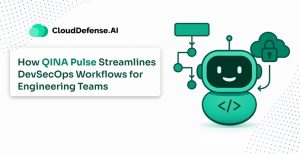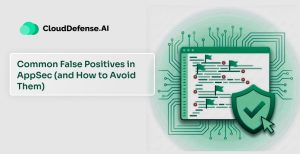With applications being the backbone of modern enterprises and a constant threat from attackers, complete security of every application has become a necessity. Moreover, development cycles are accelerating with time, and the addition of dependencies and API is making applications more complex.
Although standard application security testing methods form the backbone, they are becoming ineffective. Automation Application Security Testing is the tool for every modern organization. It moves beyond simple automation and brings an evolution to application security.
The approach combines AI, ML, and continuous monitoring to automate vulnerability detection and fix it throughout the SDLC. In this blog, we will take a deep dive into everything about automation application security testing and how it works at the speed of DevOps.
What is Autonomous Application Security Testing?
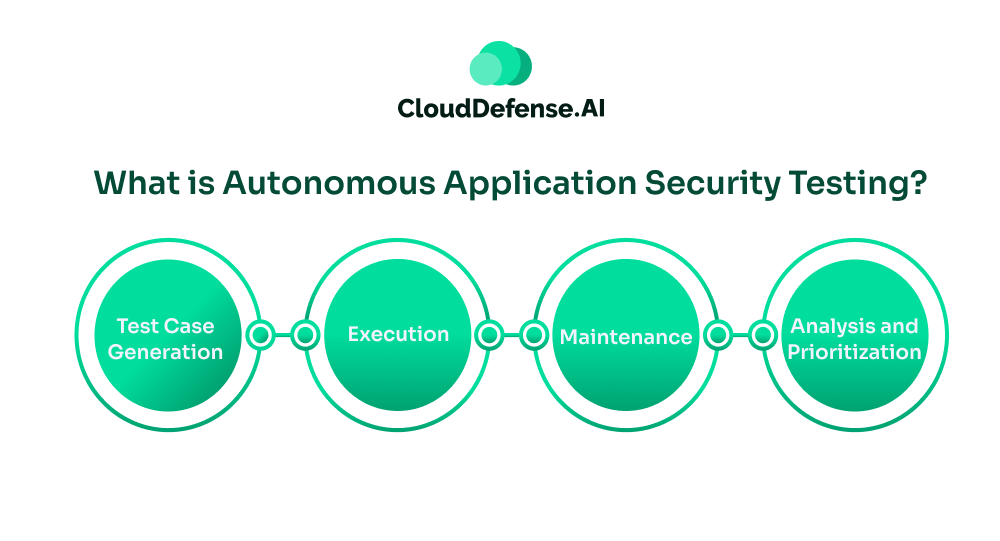
Autonomous Application Security Testing is the next-generation methodology that utilizes AI and ML to intelligently automate and manage the security testing strategy. It is an advanced application security testing approach that not only makes vulnerability detection autonomous but also enhances the identification and analysis capability.
It involves the capabilities of SAST, DAST, SCA and IAST to efficiently identify vulnerabilities, flaws, and risks in real time. However, it doesn’t take the standard testing approach that requires human interventions and relies on scripts and rules for security testing.
AAST achieves full autonomy where it understands the application’s structure, adapts to code modification, and identifies vulnerabilities independently. AAST brings autonomy to many critical tasks:
- Test Case Generation: AAST leverages AI to assess the application’s codebase, behavior, and user interaction. Based on its analysis, it autonomously creates the test script and scenario.
- Execution: Based on its analysis of the application, AAST also autonomously executes different types of tests on the application. It may execute static or dynamic security testing directly into the CI/CD pipeline.
- Maintenance: AAST automatically maintains itself according to the changes made to the application. When developers modify the codebase or UI, the tool autonomously makes changes to the script so that it can continuously test the application without requiring manual updates.
- Analysis and Prioritization: With the help of AI and ML, the tool analyzes all the security findings from the test and identifies the main reason behind the vulnerability. Based on the analysis, it prioritises the vulnerabilities and eliminates the false positives.
The main aim of AAST is to autonomously identify vulnerabilities and sometimes fix them. It helps organizations to be proactive and efficient in securing the application. Importantly, it enables the application to automatically secure itself against threats.
How Autonomous Application Security Testing Works?
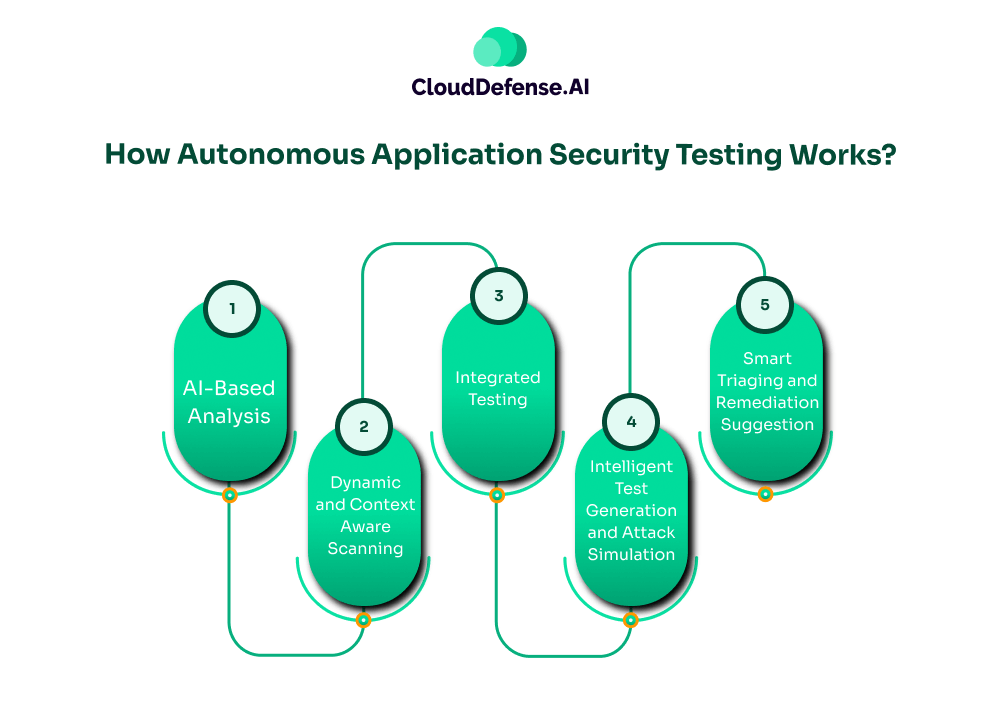
Autonomous Application Security Testing is powered by multiple technologies and processes that work together to accomplish the ultimate goal:
- AI-Based Analysis: AAST is powered by a powerful AI engine that continuously monitors the data flow, runtime behavior, and user path of the application to understand all the functions and gateways. It also analyzes all the source code, third-party dependencies, and configuration files. Importantly, it is continuously learning from vulnerability patterns and threat intelligence. Together, they enable the tool to recognize subtle differences between insecure and secure coding. As a result, it can autonomously analyze the application and identify all types of vulnerabilities, including zero-day threats and complex logic flaws.
- Dynamic and Context Aware Scanning: To offer effective application security testing, AAST combines the capabilities of SAST and DAST to identify vulnerabilities. This approach enables the tool to deeply assess the source code and runtime behavior of the application. As a result, it is able to dynamically assess the application security posture. Moreover, it also involves context-aware scanning of the application so that it can understand the context behind a code commit and the business logic of the application. It enables the tool to increase the accuracy of detection and uncover nuanced threats.
- Integrated Testing: When AAST is introduced for application security testing, it integrates directly into the CI/CD pipeline to establish AI-driven testing. It helps with proactive security, where it continuously analyzes all the code, especially code from AI-code editors, for security threats. When a threat is detected, it provides real-time feedback to the developer’s IDE and helps the team to quickly respond to it.
- Intelligent Test Generation and Attack Simulation: After thorough analysis and profiling, AAST autonomously generates and executes security tests. The AI engine identifies the segments in the application that are highly prone to threats and focuses the tests there to ensure optimum efficiency. Most importantly, it simulates real attack patterns on risk-prone segments in the application and looks for exploitable flaws. From privilege escalation risks to injection flaws, it uncovers all types of vulnerabilities. When the AAST uncovers a new path or modification in the application, the AI engine modifies the test suite accordingly.
- Smart Triaging and Remediation Suggestion: In the end, it offers smart and automated triage for all the identified vulnerabilities. It validates all the potential vulnerabilities by assessing the exploitability and business impact, and ranks them accordingly. It not only helps the developers to identify real threats but also reduces the false positives by a significant amount. Not only that, it also helps the developers with the precise location of the vulnerability along with contextual information. It provides automated ticketing and remediation guidance, enabling them to focus on high-priority threats at the earliest.
Why Organizations Should Embrace AAST: The Key Benefits
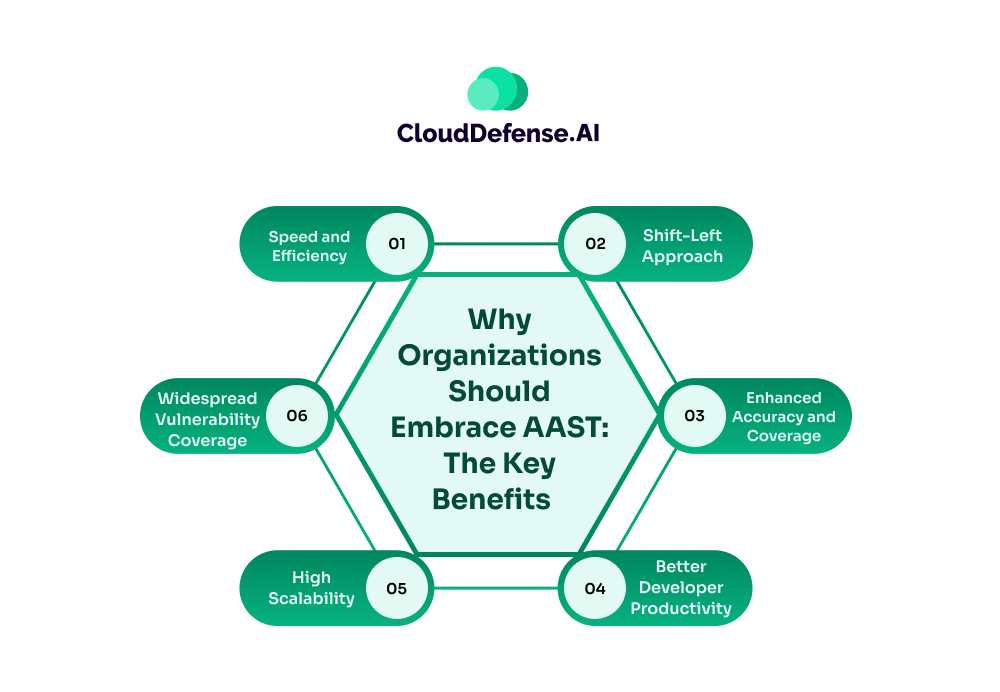
Nowadays, application security has become more important than ever. Modern organizations need to adopt Autonomous Application Security Testing as it would benefit them in many ways.
The significant benefits the tool has on offer:
- Speed and Efficiency AAST terminates the bottleneck of manual testing and automates the complete application security testing process. It integrates automated testing into the development pipeline, accelerating the complete process. The issues are identified as developers write the code, enabling them to quickly fix it before committing the code. It not only helps with faster release cycles but also provides widespread security coverage across the expanding development environment.
- Shift-Left Approach: With the adoption of AAST in the SDLC, organizations can completely incorporate the shift-left approach. It embeds security checks in every phase of the development process and ensures continuous security monitoring. This approach helps the team to easily fix flaws and ensure quicker deployment.
- Enhanced Accuracy and Coverage: AI-driven testing involves a contextual analysis and validation process, which helps in accurately identifying vulnerabilities. The high accuracy ensures only actual alerts are provided to the developers, and all the false positives are eliminated. Importantly, it explores application paths and adapts the test scenarios, ensuring broader coverage during testing.
- Better Developer Productivity: Autonomous testing, real-time alerts in the IDE, and automated remediation guidance enable the developers to address security as fast as they code. It not only minimizes distraction but also improves the overall development workflow.
- High Scalability: AAST is highly scalable and scales effortlessly to handle the increasing applications, microservices, and other components. The high scalability assists the developers in ensuring a rapid release cycle without any roadblocks.
- Widespread Vulnerability Coverage: With continuous learning from various sources and the use of AI, AAST offers a widespread coverage of vulnerabilities. From complex business logic flaws and injection vulnerabilities to zero-day exploits, it covers almost all types of vulnerabilities in application security.
How AAST is Different From Traditional Application Security Testing
AAST and traditional application security testing have the same goal of offering optimum application security. However, it overcomes all the limitations of the traditional approach and copes with the modern DevSecOps environment.
| Aspects | Traditional Application Security Testing | Autonomous Application Security Testing |
| Test Case Generation | Manual or generic scripts are used. | AI-driven test case generation based on risk and code’s structure. |
| Security Test Update | Manual update needed for change in the application. | Automatically adapt the test according to the change. |
| Human Involvement | Requires human involvement for setup and tuning. | AI engines seamlessly integrate and automatically adapt to changes. |
| Accuracy | Produces high false positives. | Use of AI and ML, offers accurate vulnerability alerts with prioritization. |
| Testing Frequency | Period testing cycle. | Continuous and adaptive testing cycle that are triggered by code changes. |
| Vulnerability Details | Provides generic reports regarding the detected vulnerability. | Provides details of the vulnerabilities with exact location of the code segment. |
| Integration | Requires manual integration. | Seamlessly and automatically integrates with CI/CD pipeline. |
Future and Challenges of Autonomous Application Security Testing
Autonomous Application Security Testing is gradually getting popular among organizations that work in a high-paced DevSecOps environment. As AI and ML evolve with the advancement of technologies, the accuracy and analysis capability of AAST is expected to be enhanced rapidly. It is also expected that AAST tools will natively integrate with many security solutions, providing a holistic overview and automated security environment.
As the need for an agile development process increases and organizations move towards more automation, the requirement for AAST is going to increase. In the near future, AAST is expected to become one of the primary pillars of application security, making every modern institute adopt it.
However, AAST comes with some serious challenges that are going to change as the tool gradually improves. The initial setup process and integration with other tools are still complex tasks and require a lot of effort. Most importantly, the AI engine is trained on multiple datasets, and its accuracy depends on the quality and integrity of the data it has been trained on.
Conclusion
Autonomous Application Security Testing has become a necessity for modern organizations as they move more towards a high-velocity DevSecOps environment. It is bringing a shift in the approach towards making application security testing completely autonomous.
AAST leverages AI and ML to make security more effective, intelligent, and proactive, which can protect the application against evolving threats. It truly makes security tests continuous and adaptive, helping developers to achieve faster development cycles. Modern organizations are gradually shifting to tools like QINA Pulse that are making security checks effortless. It acts as an AI AppSec assistant that enables developers to execute and automate security tasks with a simple English command. It is making application security testing autonomous and seamless for developers with smart prioritization, remediation guidance, and simple commands. Want to know more about QINA Pulse? Book your demo now.

